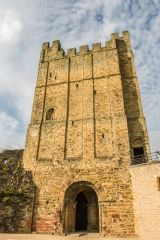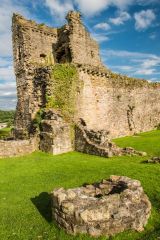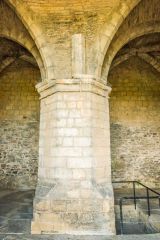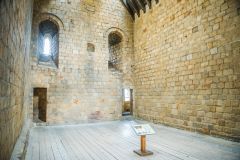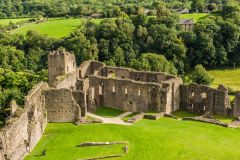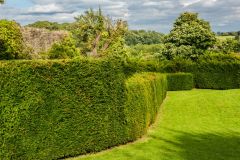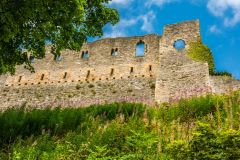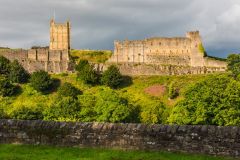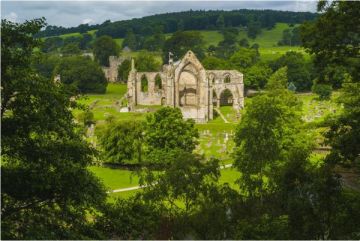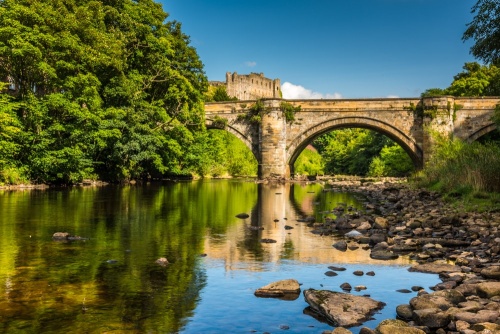
English Heritage calls Richmond Castle a 'great Norman fortress'. I'd say that's just about right. This imposing castle stands on a cliff overlooking the River Swale, at the eastern entrance to Swaledale.
It was begun by Alan 'the Red' shortly after the Conquest, as part of a huge estate known as the Earldom of Richmond. Part of its purpose was to protect the new Norman lord from possible uprising by the newly conquered Britons.
Ironically, the castle, for all its impressive size and bulk, never had to withstand a siege - or maybe the sheer imposing bulk of the thick stone walls deterred any attack.
After Alan's death the title to Richmond passed to the dukes of Britanny, in France, and for the next 300 years the dukes held, lost, and regained Richmond as they shifted allegiance between the kings of England and France.
The dukes finally lost possession for good in 1384, and in the 15th century Richmond passed through the hands of some of the great noble families of England, including the Duke of Bedford, the Nevilles, Edmund Tudor (father of Henry VII), and Richard, Duke of Gloucester (later Richard III).
Richmond Castle is unusual in that it is an early Norman fortress built in stone, whereas stone did not become common until well into the 12th century. Normal Norman practice was to quickly throw up a motte and bailey fort, basically a timber palisade atop an earthen mound, but in the case of Richmond, it appears the castle was built in stone from the start.
Alan the Red received the grant of Richmond in 1071 from William the Conqueror, and it seems that the castle was finished before he died in 1089.
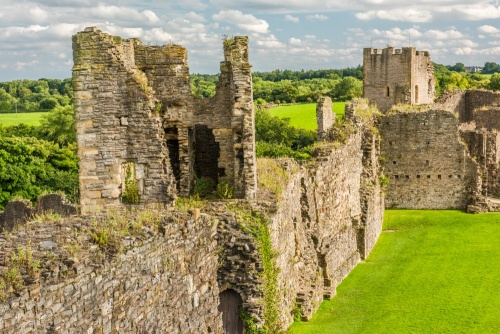
Richmond is also unusual because it was not built with a central keep but instead relied on a high curtain wall, pierced with towers, and entered through a large, well-defended gatehouse. The flanking towers that guard the gatehouse are the oldest of any English castle and are precursors of a style that would not become common for a century or more.
The Castle Keep
If you visit the castle today, the first thing that catches your attention is the strong 12th century stone keep, which seems to dominate the hilltop. But wait, didn't I just say that there was no keep?
Yes, but the keep we see today is a later addition, built by Conan the Little, Duke of Britanny, who almost completely rebuilt the original gatehouse to create this imposing structure. Only the inner gateway arch of the gatehouse was kept when the keep was built.
The keep has a vaulted ground floor, but the upper floors are reached only by a first-floor doorway. One unusual feature is that the floors are not joined by a spiral stair, which is almost universal in medieval castles. Instead, the keep has straight stairs. It is the only part of the castle to remain intact and roofed.
The clifftop castle site is triangular, and was originally protected by a wall on only two sides; the cliffs themselves deemed adequate protection on the river side. There is a ruinous wall on the river side now, but that is a later Norman introduction. If the river-ward side was considered safe from attack, the same cannot be said of the eastern approach, which had three strong square towers set into the wall.
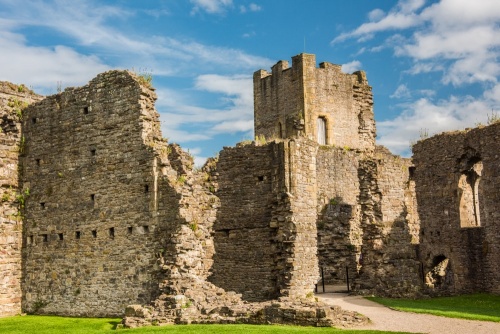
One of the towers on the east side is dubbed Robin Hood's Tower. This has a vaulted chapel at ground level. The middle tower has collapsed, but the third of Alan the Red's towers, called Gold Hole Tower, still stands. It is connected to Scolland's Hall, which is the oldest known example of a great hall in England. This was the social hub of castle life, where people conducted business, ate, drank, and slept. It is named for Alan the Red's steward.
The original hall had a small solar at one end; a private chamber for the lord. This was removed in the 14th century and a separate solar block added at right angles by John, Duke of Britanny. Duke John also heightened the eastern towers, but this limited rebuilding is the only real change wrought at Richmond Castle since the Norman period, making it one of the best examples of a Norman fortress in the country.
Visiting Richmond Castle
I came to Richmond on a regular market day - a complete accident I assure you - and the market place was crammed with people. But they'd come for the market, not to see the castle, and the castle itself was enjoyably empty of crowds. What I recall most was the drama of the impressive keep and the fabulous views from the top. That view gives you a wonderful idea of how the whole site fits together.
For an equally impressive view, go down to the riverside, and look up, to the castle towers soaring above you. It truly is an impressive site, and I can see that if Alan the Red intended to cowe his conquered Britons into submission, the castle might well have done just that. Another classic view of the castle is from Green Bridge at the western edge of Richmond.
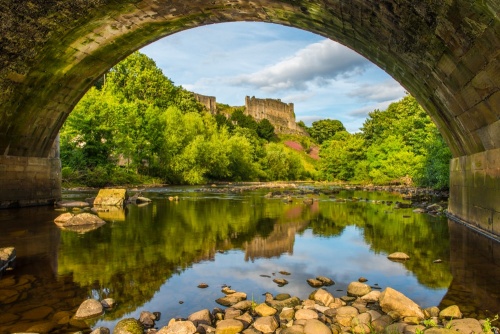
About Richmond Castle
Address: Riverside Road,
Richmond,
Yorkshire,
England, DL10 4QW
Attraction Type: Castle
Website: Richmond Castle
Location
map
OS: NZ172 008
Photo Credit: David Ross and Britain Express
POPULAR POSTS
HERITAGE
 We've 'tagged' this attraction information to help you find related historic attractions and learn more about major time periods mentioned.
We've 'tagged' this attraction information to help you find related historic attractions and learn more about major time periods mentioned.
Historic Time Periods:
Find other attractions tagged with:
12th century (Time Period) - 14th century (Time Period) - 15th century (Time Period) - castle (Architecture) - Henry VII (Person) - Medieval (Time Period) - motte and bailey (Historical Reference) - Norman (Architecture) - Richard III (Person) - Tudor (Time Period) - William the Conqueror (Person) -
NEARBY HISTORIC ATTRACTIONS
Heritage Rated from 1- 5 (low to exceptional) on historic interest
Millgate House and Gardens - 0 miles (Garden) ![]()
Green Howards Museum - 0.1 miles (Museum) ![]()
Bargate - 0.1 miles (Historic Building) ![]()
Richmondshire Museum - 0.1 miles (Museum) ![]()
Georgian Theatre Royal & Museum - 0.1 miles (Historic Building) ![]()
Grey Friars Tower - 0.2 miles (Abbey) ![]()
Richmond, St Marys Church - 0.2 miles (Historic Church) ![]()
Easby, St Agatha's Church - 0.9 miles (Historic Church) ![]()
